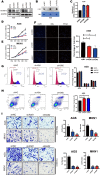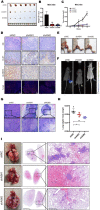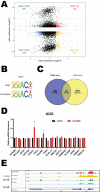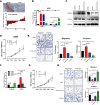ALKBH5-mediated CHAC1 depletion promotes malignant progression and decreases cisplatin-induced oxidative stress in gastric cancer
- PMID: 38007439
- PMCID: PMC10676604
- DOI: 10.1186/s12935-023-03129-9
ALKBH5-mediated CHAC1 depletion promotes malignant progression and decreases cisplatin-induced oxidative stress in gastric cancer
Abstract
The m6a demethyltransferase ALKBH5 dynamically modulates gene expression and intracellular metabolic molecules by modifying RNA m6a in cancer cells. However, ALKBH5's function in gastric cancer (GC) has remained controversial. This study demonstrates that ALKBH5 is highly expressed in GC. Silencing ALKBH5 hampers proliferation, and metastatic potential, and induces cell death in GC cells. Through a comprehensive analysis of the transcriptome and m6A sequencing, alterations in certain ALKBH5 target genes, including CHAC1, were identified. ALKBH5's demethylation effect regulates CHAC1 RNA stability, leading to reduced CHAC1 expression. Moreover, CHAC1 modulates intracellular ROS levels, influencing the chemotherapy sensitivity of gastric cancer. In summary, our study unveils the pivotal role of the ALKBH5-CHAC1-ROS axis and highlights the significance of m6A methylation in gastric cancer.
Keywords: ALKBH5; Gastric cancer; M6a; Oxidative stress.
© 2023. The Author(s).
Conflict of interest statement
The authors declare no competing interests.
Figures







Similar articles
-
ALKBH5-mediated upregulation of CPT1A promotes macrophage fatty acid metabolism and M2 macrophage polarization, facilitating malignant progression of colorectal cancer.Exp Cell Res. 2024 Apr 1;437(1):113994. doi: 10.1016/j.yexcr.2024.113994. Epub 2024 Mar 12. Exp Cell Res. 2024. PMID: 38479704
-
ALKBH5-HOXA10 loop-mediated JAK2 m6A demethylation and cisplatin resistance in epithelial ovarian cancer.J Exp Clin Cancer Res. 2021 Sep 8;40(1):284. doi: 10.1186/s13046-021-02088-1. J Exp Clin Cancer Res. 2021. PMID: 34496932 Free PMC article.
-
RNA demethylase ALKBH5 promotes ovarian carcinogenesis in a simulated tumour microenvironment through stimulating NF-κB pathway.J Cell Mol Med. 2020 Jun;24(11):6137-6148. doi: 10.1111/jcmm.15228. Epub 2020 Apr 24. J Cell Mol Med. 2020. PMID: 32329191 Free PMC article.
-
The biological function of m6A demethylase ALKBH5 and its role in human disease.Cancer Cell Int. 2020 Jul 28;20:347. doi: 10.1186/s12935-020-01450-1. eCollection 2020. Cancer Cell Int. 2020. PMID: 32742194 Free PMC article. Review.
-
CHAC1: a master regulator of oxidative stress and ferroptosis in human diseases and cancers.Front Cell Dev Biol. 2024 Oct 29;12:1458716. doi: 10.3389/fcell.2024.1458716. eCollection 2024. Front Cell Dev Biol. 2024. PMID: 39534397 Free PMC article. Review.
Cited by
-
Mechanistic insights into the role of RNA demethylase ALKBH5 in malignant tumor therapy.J Transl Med. 2025 Aug 13;23(1):905. doi: 10.1186/s12967-025-06938-w. J Transl Med. 2025. PMID: 40804394 Free PMC article. Review.
-
CHAC1 in urological tumors: contextual dualism and therapeutic implications.Front Oncol. 2025 Aug 8;15:1610915. doi: 10.3389/fonc.2025.1610915. eCollection 2025. Front Oncol. 2025. PMID: 40860820 Free PMC article. Review.
-
LOC100506691 Is an Oncogenic Long Noncoding RNA that Promotes Growth and Motility of Lung Cancer Cells.Cancer Genomics Proteomics. 2025 Sep-Oct;22(5):775-790. doi: 10.21873/cgp.20536. Cancer Genomics Proteomics. 2025. PMID: 40883019 Free PMC article.
-
ALKBH5 suppresses gastric cancer tumorigenesis and metastasis by inhibiting the translation of uncapped WRAP53 RNA isoforms in an m6A-dependent manner.Mol Cancer. 2025 Jan 15;24(1):19. doi: 10.1186/s12943-024-02223-4. Mol Cancer. 2025. PMID: 39815301 Free PMC article.
-
Metformin enhances METTL14-Mediated m6A methylation to alleviate NIT-1 cells apoptosis induced by hydrogen peroxide.Heliyon. 2024 Jan 17;10(2):e24432. doi: 10.1016/j.heliyon.2024.e24432. eCollection 2024 Jan 30. Heliyon. 2024. PMID: 38312705 Free PMC article.
References
-
- Ishimoto T, et al. Activation of transforming growth factor Beta 1 signaling in gastric Cancer-associated fibroblasts increases their motility, via expression of rhomboid 5 homolog 2, and ability to Induce Invasiveness of Gastric Cancer cells. Gastroenterology. 2017;153(1):191–204e16. doi: 10.1053/j.gastro.2017.03.046. - DOI - PubMed
Grants and funding
- 82003112/National Natural Science Foundation of China
- 81702878/National Natural Science Foundation of China
- 82173239/National Natural Science Foundation of China
- 19ykpy58/Young Teacher Training Project of The First Affiliated Hospital of Sun Yat-sen University
- 2020A1515010214/Basic and Applied Basic Research Foundation of Guangdong Province
LinkOut - more resources
Full Text Sources
Miscellaneous

